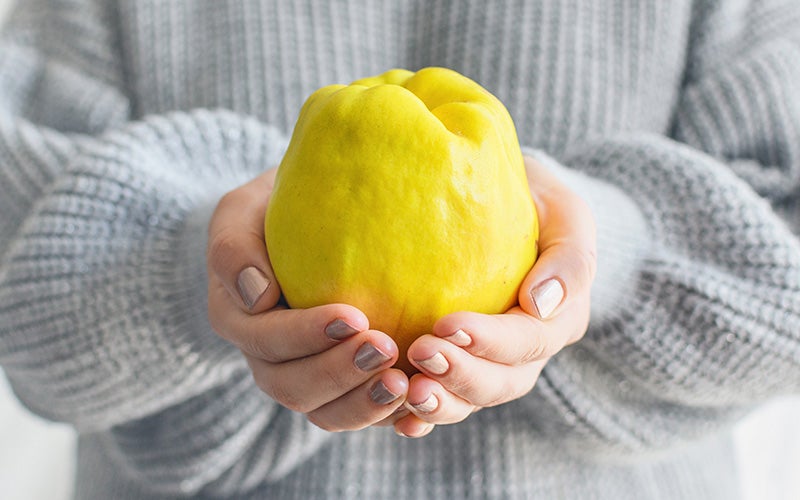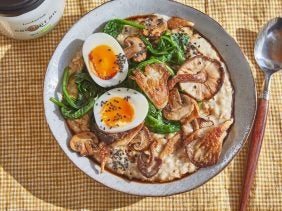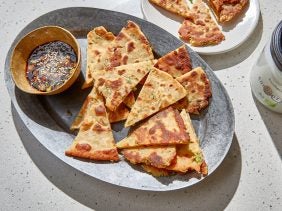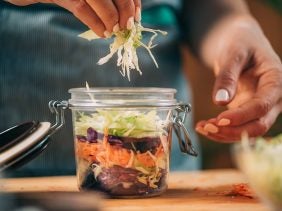Quince: Everything You Need to Know About This Underrated Fall Fruit
 ©Marko Klaric / EyeEm
©Marko Klaric / EyeEm
While you might associate fall with apples and pumpkins, there’s another great fruit at its peak during this season. From September to November, keep an eye out for quince, which has been in use and adored for its nutritional properties since the time of ancient Greece. Keep reading to find out what makes quince so special.
What is a quince?
You’d be forgiven for not recognizing a quince fruit right away. The autumnal fruit resembles both apples and pears, but tastes nothing like either. Raw quince is rock hard and quite bitter, but it becomes sweet and citrusy after some time over heat. That’s why making jams and compotes are among the most popular uses for quinces. But that’s not all it’s good for. With a little know-how, you can turn it into everything from tasty cakes to fresh, fall juices.
The two most common types of quince fruit are one that’s shaped like an apple and another that’s shaped like a pear. The former is round and very hard, whereas the latter is sweeter, softer, and easier to use.
Quince is the fruit of the quince tree, a member of the rose family. It originated in Central Asia and is now grown throughout much of Europe and the world at large. These small trees flourish in warm climates like those found in Spain, Italy, Portugal, and North Africa. But you’re far less likely to find it locally grown in a place where the temperatures are known to plummet. It blooms in summer and the fruit is usually ready to be harvested from September to early November.
Health Benefits of Quince
Don’t be fooled by their hard flesh and plain appearance: Quince is packed with flavor and nutrients. It’s been enjoyed for centuries and was even thought to have healing powers in ancient Rome.
The Romans were onto something, because quinces are full of essential nutrients like vitamin C, calcium, potassium, phosphorus, magnesium, and iron. It also contains a noteworthy amount of pectin, tannins, and dietary fiber.
Even the seeds can be tasty, healthy treats, because they contain a compound called mucilage that creates a sweet flavor profile. Leave them to dry and then try sucking on them like hard candy. But don’t try to chew on them because their insides can be very bitter.
Here’s exactly what you’ll find in 100 grams of quince fruit:
| Calories | 38 |
| Protein | 1.7g |
| Fats | 0.5g |
| Carbohydrates | 12g |
| Dietary fiber | 6 g |
| Water | 84.7 g |
How to Buy, Store, and Cook With Quince
You’re mostly likely to find quince at the farmers market from September to November. Except for in specialty stores, you probably won’t spot them at your local supermarket. When you do see them, stock up. You’ll know the fruit is ripe if it’s flesh is fully colored and its skin isn’t fuzzy.
If you have a choice, choose the long, soft variety over the hard, round variety. While the former is better for most uses, the latter will work just fine for compotes and jellies. It’ll just take a bit longer to cook.
Store unripe quince in a cellar or another cool spot until its full flavor is developed. On the other hand, process ripe quinces as soon as possible. Quince has a strong aroma that can be transferred to other fruits and vegetables in close proximity, so always try to store them separately.
How to Prepare Quince for Cooking
- Clean quince with a paper towel or rag before cooking to remove any remaining fuzz.
- Though it’s not necessary, you can peel quince if you like. Dry out the peels and save them to make an aromatic tea.
- Remove the seeds, chop the fruit coarsely with or without the skin and cook it in a pan for about 20-30 minutes until tender. You can use a pressure cooker to speed up the process.
Quince Recipes
Ready to start cooking with quince? Here are three recipes to get you started.
Quince Marmalade
Quince is excellent for homemade jams and jellies because it contains a high amount of pectin. Here’s everything else you’ll need:
- 1kg of quince
- 750 ml of water
- jelly sugar
- lemon and cinnamon to taste
Cut the quinces into pieces and boil them in water for 20-30 minutes. Stir regularly so that nothing burns. Strain the soft fruit through a sieve or cheesecloth. Reserve the fruit mixture for another use. (Try sweetening it slightly for a tasty compote!)
From there, combine the remaining liquid with jelly sugar and bring it back to a boil. Let it cook for a few minutes, then add lemon and cinnamon and transfer to an airtight jar. Let cool before sealing and transferring to the fridge.
Porridge with Quince Compote
Porridge with quince compote is a great breakfast for getting into an autumn mood. To make it, here’s what you’ll need:
- 250g of quince
- 3 tablespoons of honey or maple syrup
- 2 to 3 tablespoons of water
- Ground cinnamon to taste
Core your quince, cut it into small pieces, and transfer to a heavy-bottomed saucepan with water and sweetener of your choice. Simmer for about 10 to 15 minutes, then add the cinnamon and serve the mixture with the porridge.
Quince Crumble
This quince crumble is a treat, whether it’s for a sweet breakfast, an energizing snack, or a satisfying dessert. To make it, you need:
- 50g oats
- 50g walnuts
- 50g brown sugar
- 50g of butter
- vanilla or cinnamon to taste
- 500g quince
- 10 tablespoons honey or maple syrup
- 250ml apple juice
Chop the walnuts and mix them with the oats, brown sugar, and 3/4 of the butter, and a pinch of cinnamon or vanilla. Transfer mixture to baking sheet and let bake until just toasted, 5 to 8 minutes. Core and chop quince and cook in a small saucepan with remaining butter. Add honey or maple syrup, deglaze with apple juice, and simmer until the fruit is tender, about 10 minutes. Core the fruit, cut it into small pieces and heat it in a pan with the remaining butter. Pour the compote into a baking pan, top with the crumble and dig in!
Our tip: We have over 300 nutritious recipes that are designed with your fitness goals in mind.
Quince: Our Conclusion
- Quince is a fruit that’s harvested between September and November.
- Its flesh is fruity and citrusy.
- It can be eaten with or without the rind, but it’s not suitable for raw consumption.
- There are two types of quince: pear-shaped and apple-shaped. Both varieties must be boiled or baked before being eaten.
- It’s frequently used to make jam, compote, or juice.
- It has few calories, but lots of fiber, water, vitamins, and minerals.
- The dried seeds can be used as lozenges to suck. The dried rind can be used to make tea.
Sources for this article
We at foodspring use only high-quality sources, including peer-reviewed studies, to support the facts within our articles. Read our editorial policy to learn more about how we fact-check and keep our content accurate, reliable, and trustworthy.






















